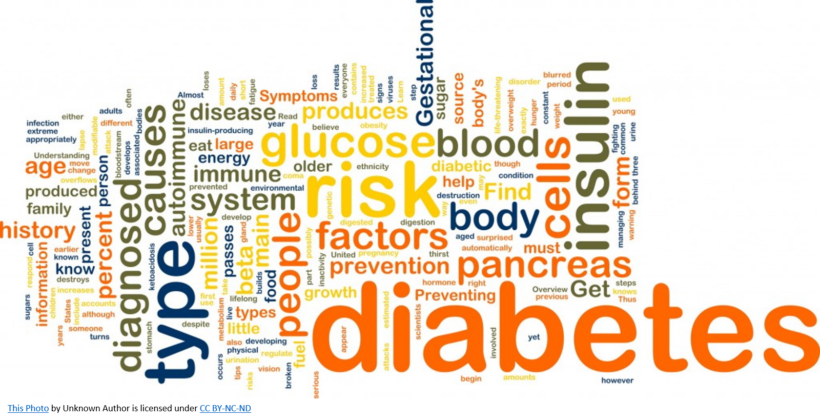What Is the Problem
Diabetes is a serious chronic health condition that affects the body in many ways. The complications of diabetes include heart disease, stroke, feet and eye problems. We are learning that having Type 1 or Type 2 diabetes also increases the risk of breaking a bone.1
According to the 2020 National Diabetes Statistics Report, more than 34.2 million Americans have diabetes, and more than 88 million have prediabetes. New cases between 2008 and 2018 were highest among non-Hispanic Black people and people of Hispanic origin. More people are developing Type 2 diabetes before age 20 because of increasing rates of obesity among young people.2
Type 1 diabetes is an autoimmune condition in which the body attacks the pancreas with antibodies. The pancreas is damaged and is unable to make insulin. Type 1 diabetes can be caused by genetics or by problems with the cells in the pancreas. In Type 2 diabetes, either the pancreas doesn’t make enough insulin, or the body doesn’t use the insulin like it should. Type 2 diabetes accounts for 90% of diabetes cases. Being obese increases one’s risk of developing type 2 diabetes.
People living with diabetes need to know about their risk of breaking a bone and how to keep their bones strong.
What We Know About Diabetes and Fracture Risk
Experts believe excess sugar in the bloodstream attaches to the collagen inside the bones. This is important because collagen makes bone tougher and less likely to break from a fall or when force is put on it. When sugar attaches to the collagen, the structure changes, making the bone less flexible and more brittle. 3 , 4
People living with Type 2 diabetes typically have higher bone density, because of increased body weight. We usually associate higher bone density with stronger bones, but with diabetics, that is not the case. People with diabetes have up to twice the risk of breaking a bone as people without diabetes.5 We also know from studying the structural properties of bone in people with diabetes that their bone strength is 10% less than in people without diabetes.6
Taking medicines that control blood sugar also can affect the bones. Although it seems that Metformin can reduce the risk of fracture, other treatments such as TZDs (Avandia™ or Actos™) actually increase the risk of fracture.7
Medications That Can Be Bad for Your Bones
What Can You Do?
Based on the results of several large research studies, American Bone Health has updated its Fracture Risk Calculator™ to reflect the elevated risk of broken bones for people living with diabetes. The Fracture Risk Calculator is a scientifically validated tool to assess your risk of breaking a bone in the next 10 years. Share your results with your health care provider if they show you are at moderate or high risk of a fracture.
Speak with your health care provider about getting a bone density test. This simple and painless test will allow you to begin a bone health plan with steps to prevent fractures.
The bottom line is that people living with diabetes need to be concerned about their bone health. Steps to take:
- Work to control blood sugar.
- Improve strength and balance to prevent falls.
- Talk to a health care provider about fracture risk and whether taking a medicine to strengthen the bones is appropriate.
References
[1] Walsh, J.S. & Vilaca, T. Calcif Tissue Int (2017) 100: 528. https://doi.org/10.1007/s00223-016-0229-0
[2] National Diabetes Statistics Report, 2020: https://www.cdc.gov/diabetes/library/features/diabetes-stat-report.html
[3] Saito M, Fujii K, Mori Y, Marumo K (2006) Role of collagen enzymatic and glycation induced cross-links as a determinant of bone quality in spontaneously diabetic WBN/Kob rats. Osteoporos Int 17(10):1514–1523. doi: 10.1007/s00198-006-0155-5
[4] Avery NC, Bailey AJ (2006) The effects of the Maillard reaction on the physical properties and cell interactions of collagen. Pathol Biol (Paris) 54(7):387–395. doi: 10.1016/j.patbio.2006.07.005
[5] Vestergaard P (2007) Discrepancies in bone mineral density and fracture risk in patients with type 1 and type 2 diabetes—a meta-analysis. Osteoporosis Int 18(4):427–444. doi: 10.1007/s00198-006-0253-4
[6] Farr JN, Khosla S (2016) Determinants of bone strength and quality in diabetes mellitus in humans. Bone 82:28–34. doi: 10.1016/j.bone.2015.07.027
[7] Kahn SE, Zinman B, Lachin JM, Haffner SM, Herman WH, Holman RR, Kravitz BG, Yu D, Heise MA, Aftring RP, Viberti G, Diabetes Outcome Progression Trial Study Group (2008) Rosiglitazone-associated fractures in type 2 diabetes: an analysis from a diabetes outcome progression trial (ADOPT). Diabetes Care 31(5):845–851. doi: 10.2337/dc07-2270
Posted: 03/26/21; Revised: 04/26/21
As a service to our readers, American Bone Health provides access to our library of archived content. Please note the date of the last review on all articles. No content on this site, regardless of date, should ever be used as a substitute for direct medical advice from your doctor or other qualified clinician.

